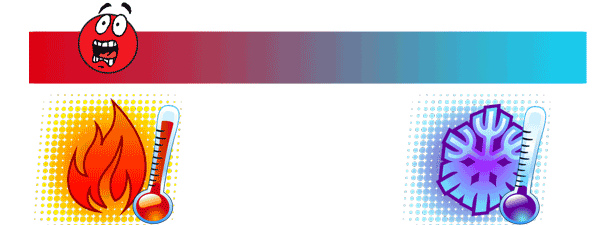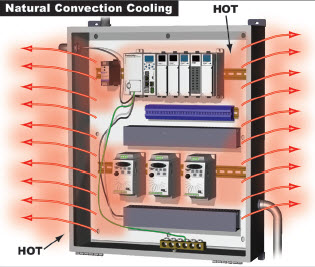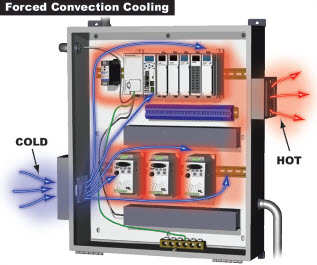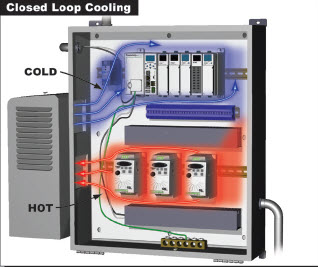Summer’s here and with temperatures climbing everyone is looking for ways to cool off. Humans crank up the AC and animals have their own special ways of keeping cool — dogs pant, pigs roll in the mud, and reptiles hide under rocks.
In some parts of the world, the heat and humidity can keep temperatures well above 90 degrees year round. Humans and animals aren’t the only ones impacted by the heat. If you’re having trouble keeping cool, then your equipment might be feeling it too and could be working overtime to try and maintain optimal performance.
All electronic devices produce heat. That’s okay in small doses, but when temperatures rise too high then a host of problems can occur. It’s not just the temperature outside that can impact equipment, internal sources as well can produce higher temperatures. For example, power supplies generate heat but these sources can also be damaged by exposure to increased temperatures.
Overheating can cause controlling units such as your PLC, HMI, AD drives, and other equipment to age quicker and that can hasten replacement. The effect of excessive heat can be overloads of your electrical and electronic components resulting in unexpected trip faults that could cause the entire system to shut down without notice.
Other external sources, in addition to the hot summer sun, can cause excessive heating. Furnaces, foundry equipment, and industrial ovens will increase the temperature inside even during the cold winter months. This could have the same result of premature aging of equipment and unforeseen power failures.
With all this heat, what’s the best way to keep your operation and equipment cool instead of feeling like Death Valley (which holds the world record for hottest temperature at 134 degrees)? There is a science behind maintaining an appropriate temperature called thermal management. This process can be broken down into a several different ways to cool equipment.
 Natural Convection Cooling.
Natural Convection Cooling.
This type of cooling takes the hot air inside an enclosure and moves it to the outside usually through an exhaust grille. This allows the heat to escape to the outside through a vent. A simple way to do this is by adding vents at the top of an enclosure to allow the hot air (which rises) to escape and install louvres at the bottom of an enclosure to draw cooler air inside.
 Forced Convection Cooling.
Forced Convection Cooling.
Cooling through forced convection is a method that forces cooler air from outside an enclosure to inside where it’s too hot. A filter fan moves the cooler outside air inside an enclosure which forces the heated air out. If your equipment is located in an area that doesn’t have any cool air, then you can reduce the temperature in the enclosure by moving (which cools) it with a fan. Fans don’t use a lot of power so they can run continuously.
Closed Loop Cooling.
 This maintains cool temperatures inside an enclosure regardless of the external environment. Closed loop cooling is the best solution for some operations where the outside surroundings are severe caused by either hot weather or other extreme conditions. There are several types of closed-loop cooling equipment available. The most familiar option is an air conditioner. An AC unit uses a refrigerant compressor that greatly enhances its ability to cool an area and can be programmed to efficiently use power. A heat exchanger is another option. This type of closed-loop cooling is used to cool an enclosure that needs to maintain its NEMA rating since it doesn’t bring any ambient air into the enclosed space and keeps it sealed tight. However, heat exchangers provide about the same cooling capacity as a fan. A third option is a compact cooler. A vortex compact cooler is smaller than an air conditioner but it needs a continuous supply of compressed air. A thermoelectric cooler is also available in very small sizes but uses approximately four times the amount of electrical power as air conditioning to cool the area.
This maintains cool temperatures inside an enclosure regardless of the external environment. Closed loop cooling is the best solution for some operations where the outside surroundings are severe caused by either hot weather or other extreme conditions. There are several types of closed-loop cooling equipment available. The most familiar option is an air conditioner. An AC unit uses a refrigerant compressor that greatly enhances its ability to cool an area and can be programmed to efficiently use power. A heat exchanger is another option. This type of closed-loop cooling is used to cool an enclosure that needs to maintain its NEMA rating since it doesn’t bring any ambient air into the enclosed space and keeps it sealed tight. However, heat exchangers provide about the same cooling capacity as a fan. A third option is a compact cooler. A vortex compact cooler is smaller than an air conditioner but it needs a continuous supply of compressed air. A thermoelectric cooler is also available in very small sizes but uses approximately four times the amount of electrical power as air conditioning to cool the area.
For tips on how to choose between convection cooling and closed loop cooling systems, read more here.
So this summer, don’t sweat it out or pant like a dog to beat the heat. Proper thermal management is a better solution to keeping things cool. Find an efficient cooling system that works best for you. And, make sure your equipment can also stay cool to maintain proper performance and avoid any unexpected damages or outages.


